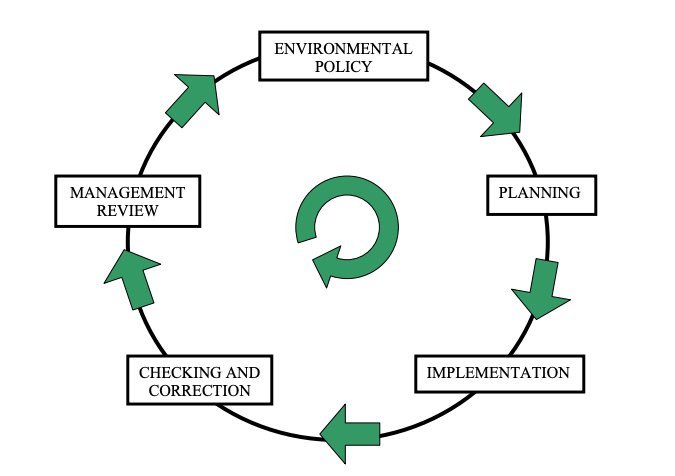An environmental management system (EMS) is “a system and database which integrates procedures and processes for training of personnel, monitoring, summarizing, and reporting of specialized environmental performance information to internal and external stakeholders of a firm”.
The most widely used standard on which an EMS is based is International Organization for Standardization (ISO) 14001. Alternatives include the EMAS.
An environmental management information system (EMIS) or Environmental Data Management System (EDMS) is an information technology solution for tracking environmental data for a company as part of their overall environmental management system.
Goals
The goals of EMS are to increase compliance and reduce waste:
- Compliance is the act of reaching and maintaining minimal legal standards. By not being compliant, companies may face fines, government intervention or may not be able to operate.
- Waste reduction goes beyond compliance to reduce environmental impact. The EMS helps to develop, implement, manage, coordinate and monitor environmental policies. Waste reduction begins at the design phase through pollution prevention and waste minimization. At the end of the life cycle, waste is reduced by recycling.
To meet these goals, the selection of environmental management systems is typically subject to a certain set of criteria: a proven capability to handle high frequency data, high performance indicators, transparent handling and processing of data, powerful calculation engine, customised factor handling, multiple integration capabilities, automation of workflows and QA processes and in-depth, flexible reporting.
Features
An environmental management system (EMS):
- Serves as a tool, or process, to improve environmental performance and information mainly “design, pollution control and waste minimization, training, reporting to top management, and the setting of goals”
- Provides a systematic way of managing an organization’s environmental affairs
- Is the aspect of the organization’s overall management structure that addresses immediate and long-term impacts of its products, services and processes on the environment. EMS assists with planning, controlling and monitoring policies in an organization.
- Gives order and consistency for organizations to address environmental concerns through the allocation of resources, assignment of responsibility and ongoing evaluation of practices, procedures and processes
- Creates environmental buy-in from management and employees and assigns accountability and responsibility.
- Sets framework for training to achieve objectives and desired performance.
- Helps understand legislative requirements to better determine a product or service’s impact, significance, priorities and objectives.
- Focuses on continual improvement of the system and a way to implement policies and objectives to meet a desired result. This also helps with reviewing and auditing the EMS to find future opportunities.
- Encourages contractors and suppliers to establish their own EMS.
- Facilitates e-reporting to federal, state and provincial government environmental agencies through direct upload.
EMS Model

An EMS follows a Plan-Do-Check-Act, or PDCA, Cycle. The diagram shows the process of first developing an environmental policy, planning the EMS, and then implementing it. The process also includes checking the system and acting on it. The model is continuous because an EMS is a process of continual improvement in which an organization is constantly reviewing and revising the system.
This is a model that can be used by a wide range of organizations from manufacturing facilities to service industries to government agencies.